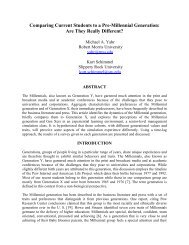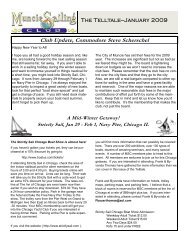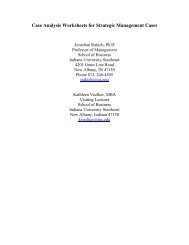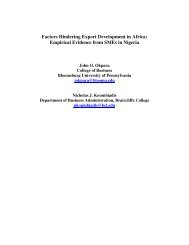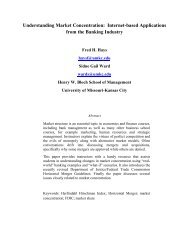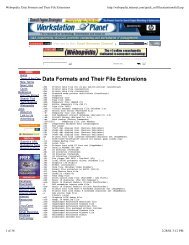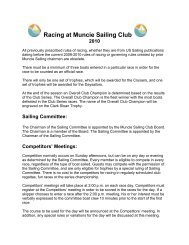Active versus Passive Management of International Mutual Funds ...
Active versus Passive Management of International Mutual Funds ...
Active versus Passive Management of International Mutual Funds ...
Create successful ePaper yourself
Turn your PDF publications into a flip-book with our unique Google optimized e-Paper software.
little similarity between mutual fund rankings when alternative benchmarks were utilized [59].<br />
Sharpe [74] reiterated the need to define terms and benchmarks when making<br />
comparisons to measure performance. He defined the terms active and passive investor and<br />
determined that the best way to measure performance was with a comparative alternative [74].<br />
At the same time, Fama [34] reaffirmed the existence <strong>of</strong> market efficiency in relation to EMH.<br />
He noted that certain markets, such as the international market with limited information,<br />
provided opportunities for abnormal returns [34].<br />
Ambachtsheer [2] proposed that an active manager must add value rather than just adding<br />
more assets to an asset-based fee schedule. In addition, it is important to note that 60% <strong>of</strong> the<br />
funds available are actively managed.<br />
Using the Morningstar Style Boxes, Bogle [18] determined that index funds were a better<br />
investment than actively managed funds. Bogle’s results were again supported for a 10-year<br />
period ending in 2001, when he found that the risk-adjusted return <strong>of</strong> the index fund was superior<br />
to the respective actively managed fund in eight <strong>of</strong> the style boxes [17]. Fortin and Michelson<br />
[39] reaffirmed that anomalies exist in the market, but indexing is still the best option for<br />
investors. They observed that active managers outperformed the associated index in only the<br />
small capitalization funds [39].<br />
Flood and Ramachandran [36] noted that both active and passive management styles had<br />
strengths and weaknesses. Their research did not favor one style as an alternative to the other.<br />
They felt the styles should be complementary [36]. Davis [28], Damato [27], and Frino and<br />
Gallagher [40] <strong>of</strong>fered additional support for the use <strong>of</strong> index funds in their studies. They noted<br />
that the passively managed funds outperformed the actively managed funds in most cases, but<br />
that anomalies still existed.<br />
Fortin and Michelson [38] observed an anomaly in their study as they discovered actively<br />
managed small company equity funds and international stock funds significantly outperformed<br />
the index over most <strong>of</strong> their study period. Their research continued to support the ability <strong>of</strong><br />
active managers to gain excess returns above the index in international markets.<br />
Adrangi, Chatrath, and Shank [1] showed further support that active managed funds<br />
could beat the index at least in the short term. Their study was limited in scope. They used the<br />
Treynor [84], Sharpe [75], and Jensen [52] performance measures [1]. Arnott and Darnell [7]<br />
concurred that it is possible to add value, as evidenced by the articles in the academic journals,<br />
the investment management practice experience, and by capital market observers. The rationale<br />
for this conclusion is that market inefficiencies and anomalies exist [7].<br />
Kjetsaa [57] compared the Morningstar style boxes to the comparative Russell indices,<br />
Standard and Poors 500 (S&P 500), and the fund category averages. He observed that a superior<br />
portfolio may contain a blend <strong>of</strong> index and actively managed funds [57]. Blitzer [13] added a<br />
behavioral link to beating the market as he believed that there will always be someone who feels<br />
they can do better than the index. He believed the use <strong>of</strong> computers would allow financial<br />
engineers the ability to create portfolios they suspected would beat the index [13].<br />
Fortin and Michelson [37] found that actively managed international mutual funds outperformed<br />
their respective indices in four <strong>of</strong> the five categories they identified. They further<br />
documented that net mutual fund assets <strong>of</strong> $134 billion in 1980 increased to more than $6 trillion<br />
in 2002 and that more than 49.6% <strong>of</strong> American households own some type <strong>of</strong> mutual fund [37].<br />
The newest revelation in financial engineering, the concept <strong>of</strong> fundamental indexing was<br />
initiated by Arnott, Hsu, and Moore. They noted the advantages <strong>of</strong> cap-weighting could be<br />
combined with additional selection methods for equities which would increase the return to<br />
4



